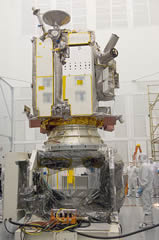ISRO and NASA Joint Exploration for Water on Moon

(Click on the Image to Zoom and know more )Indian Space Research Organisation (ISRO) and NASA performed a unique joint experiment on Aug. 21, 2009 that could yield additional information on the possibility of existence of ice in a permanently shadowed crater near the North pole of the moon. Known as Bi-Static Experiment, it involved ISROs Chandrayaan-1 and NASAs Lunar Reconnaissance Orbiter (LRO) spacecraft. Currently, Chandrayaan-1 and LRO are orbiting the Moon. The two spacecraft passed close enough to one another when they were over the lunar North pole to attempt this interesting experiment. Both Chandrayaan-1 and LRO are equipped with a NASA Miniature Radio Frequency (RF) instrument that functions as a Synthetic Aperture Radar (SAR), known as Mini-SAR on Chandrayaan-1 and Mini-RF on LRO. Since Chandrayaan-1 orbital operations began in late 2008, its Mini-RF, also known as Mini-SAR (Synthetic Aperture Radar), has mapped about 80 percent of both of the moon’s poles and provided images of areas never seen from Earth. Its second imaging period is set to begin in mid-August, opening the possibility of unique, joint measurements between Chandrayaan-1 and LRO that would enhance the hunt for ice.Chandrayaan-1 in transmit mode transmitted the signals and LRO received the reflected signals. The experiment used both radars to point at Erlanger Crater at the same time. The Bi-Static observations were made on August 21, 2009 at 00:30 hours (IST). Before the experiment commenced, LRO executed a minor manoeuvre to adjust its orbit to the well-established Chandrayaan-1 orbit. The data was collected for about 4 minutes. MiniSAR of Chandrayaan-1 was fine tuned for making observations in terms of pulse width, range rate sampling as well as its 200 km orbit height.Having two very complementary instruments orbiting the moon on two different spacecraft shows how truly international the exploration of the moon can be. ISRO declared the operations went on as planned.
The historic combined flight was tracked by Isro's deep space network at Byalalu, Bangalore and Nasa's deep space network and Applied Physics Laboratory in Maryland, US. Annadurai had been quoted as saying that the launch of LRO will lead to co-ordinated operations between both spacecraft. LRO was launched on June 18, 2009 from the Cape Canaveral Air Force Station in Florida.Click here to visit LRO on NASA's official website.
Click Here for ISRO's Chandrayaan Official Website.
Presently the collected data is being analysed by the scientists of ISRO and NASA.

